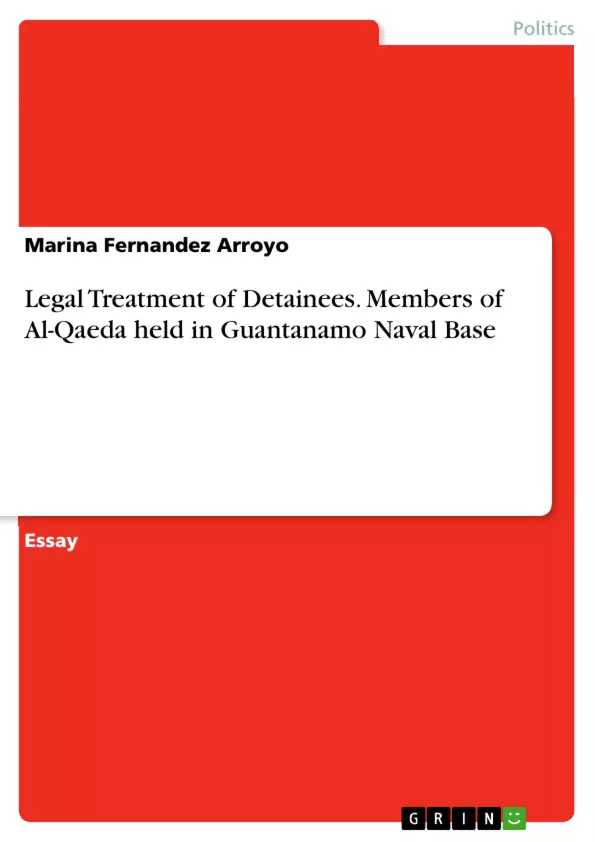After the terrorist attacks against the United States on September 11, 2001, two United Nations Security Council resolutions (resolutions 1368 and 1373) acknowledged the right to self-defence of the US following article 51 of the UN Charter. The US requested the Taliban regime's (the government at the time in Afghanistan) assistance to capture Al-Qaeda, whose main infrastructure was established in the country. The refusal of the Taliban resulted in an international armed conflict (hereinafter IAC) against Afghanistan, being that the Taliban were the de facto government hosting terrorists, and against Al-Qaeda that was de facto under effective control of the Taliban. As a result, during the conflict, members of the Taliban regime and Al-Qaeda were detained sharing the same fate, indefinite detention in Guantanamo.
Inhaltsverzeichnis (Table of Contents)
- Treatment of Detainees members of Al-Qaeda held in Guantanamo Naval Base, captured in 2001 by the United States during the conflict in Afghanistan
- The Status of Detainees
- Two Armed Conflicts?
- Legal Black Hole
Zielsetzung und Themenschwerpunkte (Objectives and Key Themes)
This document examines the legal status of detainees held in Guantanamo Bay Naval Base, specifically members of Al-Qaeda captured during the conflict in Afghanistan. It analyzes the application of international humanitarian law (IHL) and human rights law to the situation of these detainees, focusing on the contentious issue of their classification as "unlawful combatants" and the implications of this designation.
- The legal status of Al-Qaeda members detained in Guantanamo Bay
- The application of international humanitarian law (IHL) to the conflict in Afghanistan and the War on Terror
- The distinction between combatants and civilians under IHL
- The role of human rights law in the treatment of detainees
- The US government's approach to the legal status of detainees and the concept of "unlawful combatants"
Zusammenfassung der Kapitel (Chapter Summaries)
- Treatment of Detainees members of Al-Qaeda held in Guantanamo Naval Base, captured in 2001 by the United States during the conflict in Afghanistan: This chapter introduces the context of the detention of Al-Qaeda members in Guantanamo Bay, following the 9/11 attacks and the US intervention in Afghanistan. It discusses the legal framework governing the treatment of detainees, including the Geneva Conventions and the distinction between combatants and civilians.
- The Status of Detainees: This chapter examines the specific legal status of Al-Qaeda members under IHL. It argues that they do not meet the criteria for prisoner of war (POW) status and are therefore considered civilians. This raises questions about their protection under the Fourth Geneva Convention and the US's right to detain them indefinitely.
- Two Armed Conflicts?: This chapter explores the US government's argument that two armed conflicts were occurring: an international armed conflict (IAC) against Afghanistan and a non-international armed conflict (NIAC) against Al-Qaeda. It analyzes the implications of this view for the legal status of detainees and the applicability of the Geneva Conventions.
- Legal Black Hole: This chapter discusses the controversies surrounding the US's legal approach to the detainees in Guantanamo. It argues that the US government has created a "legal black hole" by evading the application of both domestic and international law, leaving the detainees in a state of legal limbo.
Schlüsselwörter (Keywords)
This document focuses on key concepts such as international humanitarian law (IHL), Geneva Conventions, combatants, civilians, unlawful combatants, prisoner of war (POW) status, detention, Guantanamo Bay, Afghanistan, Al-Qaeda, War on Terror, human rights law, and the legal status of detainees.
- Quote paper
- Marina Fernandez Arroyo (Author), 2016, Legal Treatment of Detainees. Members of Al-Qaeda held in Guantanamo Naval Base, Munich, GRIN Verlag, https://www.grin.com/document/354413



